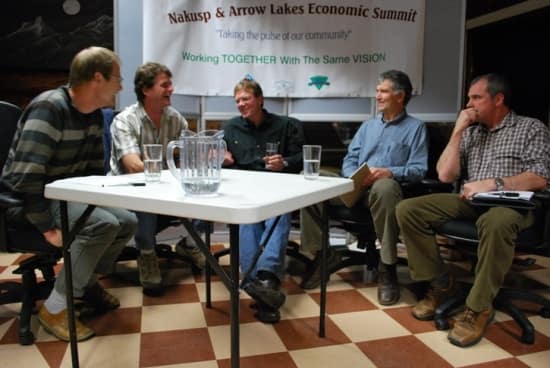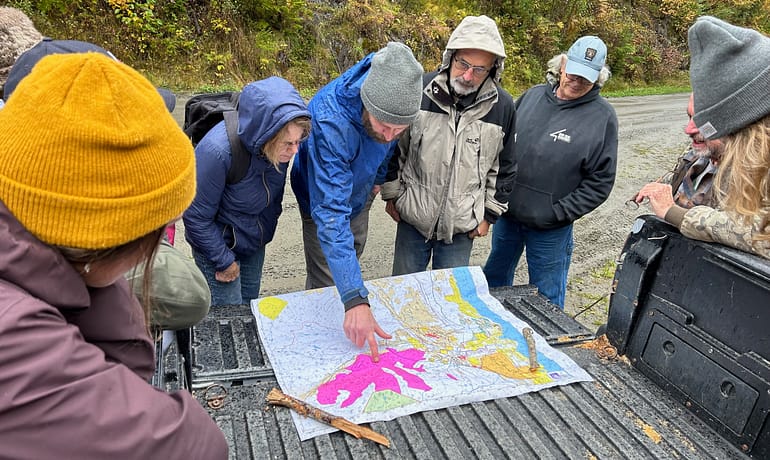Forestry is down, and it’s most likely not going to be where it was four years ago again, but that doesn’t mean there aren’t opportunities in Nakusp.
By Sam Smith – Arrow Lakes News
Published: November 10, 2010 3:00 PM
Updated: November 10, 2010 3:05 PM
Forestry is down, and it’s most likely not going to be where it was four years ago again, but that doesn’t mean there aren’t opportunities in Nakusp.
This was the lasting message of the latest economic meeting in the village, featuring five forestry experts in a panel hosted by Bob Toews and Laurie Page on Wednesday, Nov. 3.
On the panel was Interfor’s Geoff Bekker, Jesper Nielsen of NACFOR/True North Forestry, Coun. Cam Leitch, Jim Guido from the ministry of forests, mines and lands, and Dan Wiebe of Box Lake Lumber.
As the meeting started, Kim Reich, president of the Nakusp & District Chamber of Commerce (COC), opened it up before handing the hosting over to Page and Toews.
“Hopefully this will give some hope to our community in regards to forestry,” she said.
And what better way to provide hope than to provide ideas. And that’s what Wiebe did for everybody in attendance.
“We have no way of getting rid of wood-waste,” Wiebe said. “It would be a lot easier to start out in Revelstoke.”
Wood-waste is a by-product generated during the manufacturing and production process of wood. Basically, they’re solid wood particles left over. There are a few ways to dispose or utilize wood-waste, and that’s why Wiebe believes there to be a huge opportunity there.
“Realistically, the community could set up something with BC Hydro which could create jobs,” he said.
Wiebe went on to say wood-waste can be used for energy using a machine called a Cogeneration Plant, or cogen for short. This machine takes these wood particles, heats them up and simultaneously generates both electricity and steam which can be converted to energy.
“Nakusp is one of the few places that can go to BC Hydro and say you owe us,” he said. “So why can’t Nakusp do something along these lines? We get BC Hydro to commit to buying electricity.”
Wiebe said the cogen would create jobs, is a good energy source and would help bring income into the town.
“I can’t see why it wouldn’t work here,” he said.
Wiebe said had he known about this wood-waste problem before he set up shop in Nakusp, he wouldn’t have opened his business here. The problem needs a solution if Nakusp wants more businesses like his.
The other panelists spent time going over how forestry is looking in their sectors, and that can directly effect the village.
Geoff Bekker said they are working at 60 per cent of what they were doing three to four years ago, and he expects it to stay about the same for next year.
Bekker recommended looking at other jobs, such as this wood-waste opportunity, rather than waiting and relying on the forestry industry to grow back.
He also mentioned the village could have one organizer in the community that Interfor goes to, because right now they don’t have anyone like that.
Jesper Nielsen said NACFOR is working under 50 per cent of its allowable annual cut (AAC), logging about 8,000 cubic metres by the end of the year. They are allowed 20,000 in total.
He said it’s not a problem with being ready or prepared, but there are just not enough markets for the timber they can log here right now.
“Basically, it comes down to markets,” he said. “We’re a seller. We can’t go out and log at a loss and be super-efficient millers.”
Nielsen also said there’s a need for people to step forward and sit on their sub-committees.
Cam Leitch said the regional district is conducting a bio-energy feasibility study that the village could look at when it’s done, to see if there is opportunity there.
Jim Guido from the ministry pointed out that Springer Creek Forest Products in Slocan City looked at cogens for their community. Nakusp could speak with them to learn of their experience.
Wiebe was given a chance to answer what he would like from the village at the end of the meeting as well.
“The forest industry will never be what it was,” he said. “It’s just not like that anymore. So we need to think of jobs for younger people.”
Jobs such as a small forestry operation concentrating on niche markets, and ways of producing energy, such as the cogen or a turbine in the Kuskanax River.
In the end, people were there to find out what they could realistically do to help bolster up forestry in the area, which would in turn help the village.
Bob Toews pointed out, using the charts Victor Cumming used in the original meeting, that forestry is a basic, direct employer to the village, and that’s why it’s so important.
“We need to take these ideas we talked about here, throw it into the funnel, and start working on one or two of them,” Toews said.
The next meeting is scheduled for Nov. 24 and will concentrate on tourism.
Related Post
Province increases funding for community forest wildfire risk reduction
News Release We are pleased to announce that the
BC introduces new measures on old growth, innovation, forest stewardship
New announcement on process and funding for policy reforms



